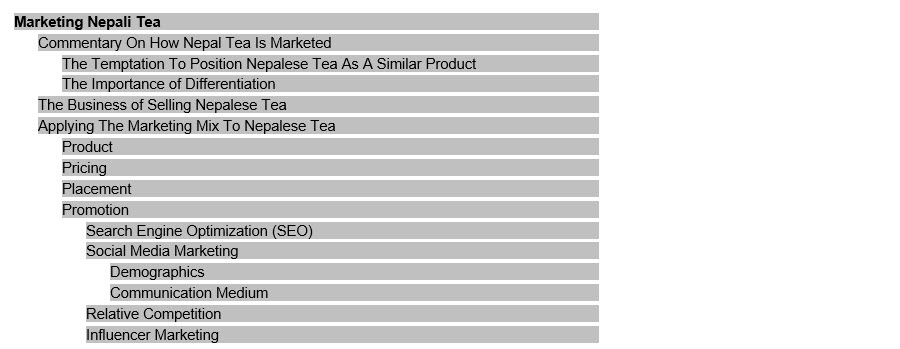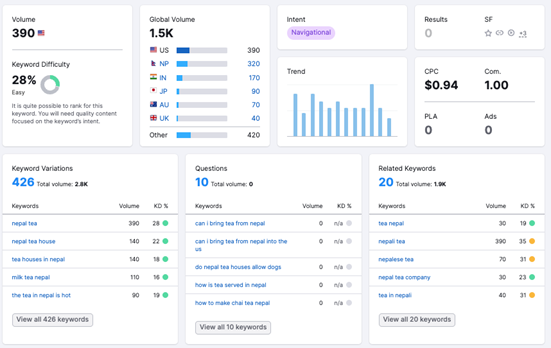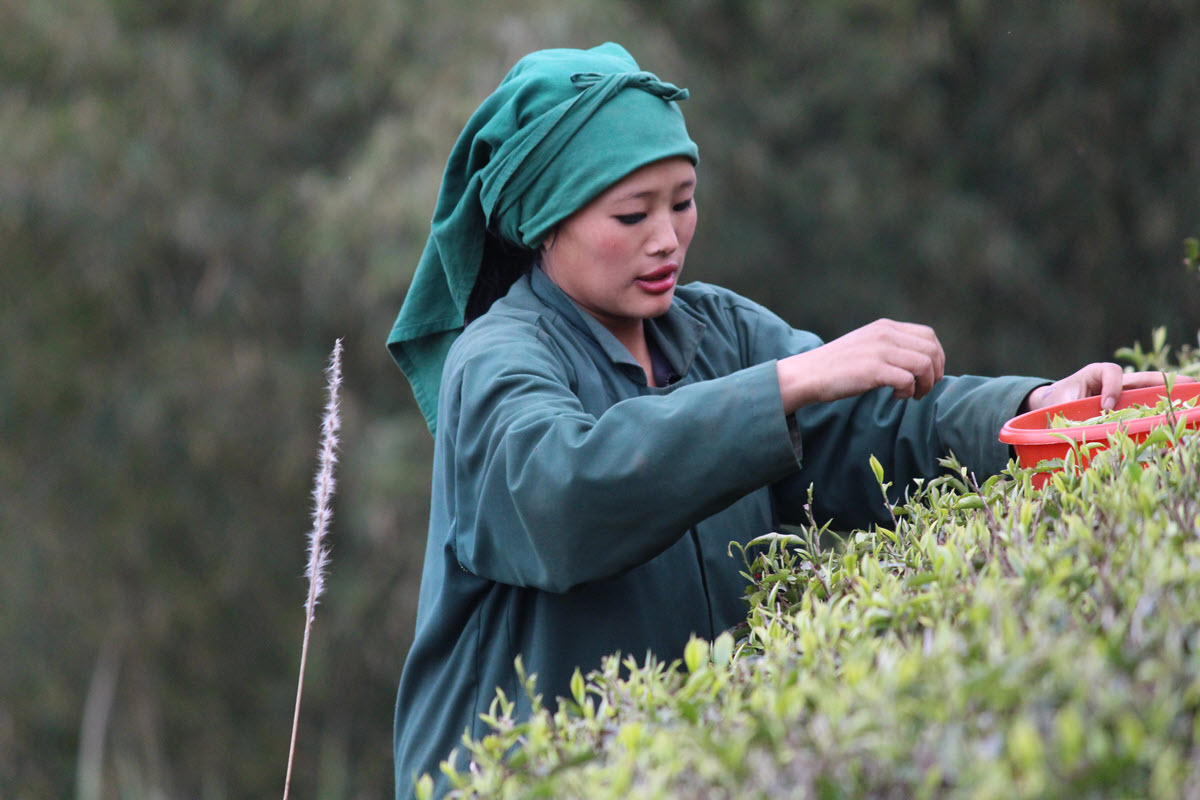
Nepal is investing in marketing its tea globally.
Three million of the 30 million people who live in Nepal find work in tea. Most are unskilled, lower-paying jobs harvesting raw leaves, but many new opportunities are emerging to expand smallholders’ production of high-quality tea. Currently, there are 16,920 hectares under tea. Production of orthodox tea on certified tea lands was 7,168 metric tons, according to Nepal’s National Tea and Coffee Development Board (NTCDB). An assessment using Geographical Information System (GIS) data reveals that 1.8 million hectares of land are suitable for cultivating orthodox Nepali tea.
“Nepali tea has demonstrated great domestic and international market potential,” according to the tea and coffee development board.
“However, exporting to developed markets requires improving quality consistency and certified compliance, particularly regarding maximum residue levels and other food safety-related matters, to meet the market demand. Teas exported to Europe are exclusively organic and IMO certified. Some importers also ask for additional certifications, including Fairtrade and Rainforest Alliance.”
Most tea is cultivated on 146 plantations in the eastern part of the country in a region known as the Terai. Two large exporters, Himalayan Shangri-La Tea and Gorkha Tea Estate, are shipping large quantities of third-party certified tea to Germany (where TeeGschwendner markets it). Smallholders growing tea on farms of 10 hectares or less have expanded operations. NTCDB lists 14,039 smallholders. Tea is now grown in 46 districts, with commercial operations in 14 districts. Annual production was 23,745 metric tons in 2021, of which 772,455 kilos was green tea.
Tea Journey Marketing Director Mackenzie Bailey coordinated with Aasha Bhandari at HIMCOOP to meet the marketing goals of the NISTEP (Nepal’s Increased Sustainable Tea Exports Project) underMinistry of Industry, Commerce, and Supplies. Mackenzie is the founder of Steeped Content; she helps tea businesses grow through digital marketing, offering a range of services. If you have questions, consider joining Infused live or booking a free consultation.
I am confident that growers and small brands will find the marketing plan that follows quite useful.

Dan Bolton, Founder Tea Journey Magazine
Marketing Nepal Tea

The Nepali tea industry has the potential to grow and prosper. However, for this to happen, effective marketing strategies must promote Nepali tea domestically and internationally.
There are several reasons why marketing is vital for Nepali tea brands.

Avoid the Temptation to Position Nepalese Tea as a Similar Product
When marketing tea from an unfamiliar origin, the temptation is to position it as similar to tea from a well-known origin. For example, tea from Nepal is often marketed like Darjeeling tea.
There are similarities between Nepali and Darjeeling teas. Both are grown in the Himalayan mountains and can be within close geographic proximity, implying a similar terroir. For example, Makaibari Tea Estate in Darjeeling, India, is roughly two hours drive from Organic Nepal Tea Industry Pvt in Nepal.
The Importance of Differentiation
Yet Nepal’s teas are not identical to Darjeeling tea or other Indian tea. Nepali tea is a unique product with a distinct flavor profile.
Differentiation, essential in any market, is critical in the international tea market. Suppliers and brands must offer buyers a unique and appealing product to stand out from the competition.
Only through differentiation can product demand be created for Nepali tea.
The Business of Selling Nepalese Tea
Nepal tea producers need to determine how they will bring their tea products to market.
Tea produced in Nepal can either be sold Business-to-Business (B2B) or Direct-to-Consumer (D2C). A producer’s selection of a B2B or D2C business model impacts distribution and the tea supply chain created.
B2B sales involve selling tea to another business, which will then resell the tea to consumers. For example, Nepal Tea Collective may produce tea and sell it to a large tea retailer, such as DAVIDsTEA, which sells it to consumers.
D2C sales involve selling tea directly to consumers through online stores or brick-and-mortar retail shops. For example, Nepal Tea Collective may produce tea and bring it to the global market through its website.
A Nepalese tea company, such as Nepal Tea Collective, may also choose to expand D2C sales by creating a tea affiliate marketing program, rewarding affiliates (e.g., influencers creating tea blogs) for driving product sales.
With a cash injection (e.g., private investment, a government subsidy) some tea producers in Nepal may consider testing dropshipping tea as a business model, further supporting tea exports.
For example, individuals in markets where Nepali tea has a reliably low presence (e.g., America) may launch a Shopify store selling Nepalese tea. Marketing this tea would be outsourced to these individuals.
Drop shipping may support the gradual premiumization of Nepali tea in the market. Sellers (e.g., those running a Shopify store) are incentivized to set higher price points; they earn the difference between the retail price and the supplier’s price.
Applying The Marketing Mix to Nepalese Tea
Product
Product is an element of the marketing mix and refers to the physical goods a company offers for sale.
Here are four ways to differentiate Nepalese tea with marketing:
- Highlight unique flavor profiles. Nepal tea is known for its muscatel and malty flavor due to the terroir of the region where it is grown.
- Build up the lore of terroir. Nepal’s terroir is perfect for growing tea, with high altitudes, cool temperatures, and plenty of rainfall.
- Emphasize product purity. Many tea farmers in Nepal use (uncertified) organic farming practices, so brands may have an opportunity to emphasize product purity, increasing the product’s perceived value.
- Use storytelling to highlight the unique aspects of origin. Nepal tea offers a compelling story rooted in the country’s rich history, culture, and landscape.
The fourth tactic, using storytelling to highlight the unique aspects of origin, is a powerful opportunity. For example, Nepal is home to some of the world’s most iconic mountains, including Mount Everest, and its tea gardens are nestled in the foothills of these majestic peaks.
When you market Nepal tea, you are not just selling a product but an origin story. The story of teamaker Sharad Subba in “Tea Processing at Innovative Jasbire Tea Factory” exemplifies this tactic in action. As does the story of the tea plucker, Purnima Rai, in “Purnima Rai’s Nepal Garden.”
Pricing
Pricing tea requires selecting a pricing strategy (e.g., premium pricing, penetration pricing).
Nepal tea is priced lower than many teas on the market (e.g., Darjeeling tea).
One reason is that Nepal is a developing country; its tea industry is less developed than other countries.
Another reason Nepalese tea is priced lower than competing products is that the Nepal government is actively investing in marketing Nepal tea to boost the country’s economy. As a result, Nepal tea may be sold at a discount to attract large buyers.
Aasha Bhandari, International Trade and Promotion Executive at HIMCOOP, notes, “We have good quality tea, but we need to focus more on marketing, pricing, and our strategy to promote it in the international market.”
Some businesses use price anchoring to increase sales by making their products seem more affordable. For example, one pound of Darjeeling tea may sell for $288, but a comparable Nepalese tea may sell for $200, representing a $88 cost saving per pound. This is an effective way to get tea buyers (e.g., retailers and wholesalers) to buy items they might not have considered otherwise.
Placement
Placement, within the context of the marketing mix, is the process of getting the product (tea) into the consumer’s hands. Various sales channels, such as retail stores, online retailers, and distributors, offer distinct advantages.
The main goal of placement is to make the product available and convenient for consumers to purchase. One of the best placement opportunities for Nepalese tea is on other companies websites.
The best tea websites typically invest in developing rich product pages, making product discovery easy (e.g., offering a good user experience), and building affinity with consumers on their About page.
Three marketing principles can guide effective placement decisions through accurate inferences.

Promotion
Promotion informs your target audiences of the relative merits of a product (tea) brand in a persuasive and timely nature. Therefore, promotions should be considered alongside product, price, and placement when forming your marketing strategy.
Nepalese tea brands can market their products in many ways, for example:
- Advertising (e.g., creating great tea ads that entice consumers),
- Public relations (e.g., flying journalists out to visit the tea farms of Nepal),
- Events (e.g., suppliers of Nepali tea attend the World Tea Expo to promote their products)
- Email marketing (e.g., brands can build an engaged list of email subscribers by replicating the tactics of the best tea newsletters), and
- Content marketing (e.g., a dedicated Nepal issue in Tea Journey Magazine).
And while there are many options for promoting Nepali tea, here are three marketing tactics and channels that Nepalese tea brands should consider:
- Search engine optimization (SEO)
- Social media marketing
- Influencer marketing
Search Engine Optimization (SEO)
Search engine optimization (SEO) increases the quality and quantity of website traffic. It can be a powerful tool for marketing Nepal tea across the board.
For example, “Nepal tea” is searched 1.5K times per month globally and is “easy” to rank for, requiring quality content focused on the intent of the keywords.

Different retailers and bloggers can compete to gain a greater traffic share by targeting specific keywords and optimizing product pages and blog posts to further that end.
For example, “tea houses in Nepal” is searched 300 times per month globally, and 140 of those searches occur in the United States at the time of writing. Therefore, by producing a list-style article, such as “15 Stunning Tea Houses In Nepal,” a Nepalese tea brand can increase its website’s traffic.
By creating blog content rich in keywords, Nepal tea companies can ensure their products are being discovered by people actively searching for them.
Social Media Marketing
Social media marketing can be a powerful tool to help drive interest in Nepalese tea.
Social media allows humanity at origin to shine through. By creating and sharing engaging content about Nepal tea, brands can connect with potential customers and build an affinity for Nepalese tea, people, and culture.
Social media can create a buzz around Nepalese tea; brands can use it to help increase awareness and interest in this unique product.
Nepalese tea brands should consider three attributes of social media platforms when determining which channel is best to promote their business:
- Demographics
- Communication medium
- Relative competition
Demographics
Creating content for social media requires considering the demographics of the audience you are trying to reach. For example, if you are targeting a younger audience, you may want to use platforms like Snapchat or Instagram. On the other hand, if you are targeting an older audience, Facebook or Twitter may be more effective.
Communication Medium
Brands should also consider which communication medium – text, image, or video – they are most skilled in producing content and which suits the product and communication objectives best.
For example, Instagram can be an excellent platform for sharing beautiful photos of Nepali tea. Brands may also use YouTube to create engaging videos about Nepal tea (e.g., garden tours and tasting videos). Increasingly, engaging videos are distributed on Instagram and TikTok.
View this post on Instagram
Relative Competition
Individual brands may want to assess the relative competition of social media platforms (content saturation). For example, if a competing tea brand focuses primarily on Facebook, other platforms like TikTok may prove more effective.
By using a variety of social media platforms, brands can reach a wider audience and create a more comprehensive marketing campaign for Nepal tea.
Influencer Marketing
Influencer marketing can be a powerful tool to help promote Nepal tea. By working with tea influencers, brands and organizations (e.g., HIMCOOP) can promote unique teas from Nepal.
For example, Nepal Tea Collective worked with tea influencer Nicole Wilson to produce this post.
View this post on Instagram
By partnering with influencers, Nepalese tea brands can reach a wider audience and promote the nation’s tea to a larger group. This can help to increase sales and support marketing efforts.
Over time influencer marketing can increase product awareness and sales.
Collaborating with influencers adjacent to the tea industry (e.g., travel influencers) allows for creating content showcasing Nepal’s beauty and its people. This may help attract more visitors to the country, benefiting Nepal’s economy.
There are several ways to work with influencers, such as:
- Sponsoring content,
- Collaborating on social media campaigns, and
- Providing free products.

Tea Market
Get More Value from Your Tea: BRU Maker One
+41794574278
Jacque's Organics
(647) 804-7263